From
my recent diary
2017
Sunday, December 24
Air temperature was zero degree Celsius and it was rather warm, but
transparency was not good corresponding to it. Katsumi Yoshimoto reported
C/2017 T1 Heinze as a magnitude of 11.7 and I tried observing the comet.
At 4:10am local time I aimed my comet-seeker at the position. I could not
notice the object at a glance and spotted it refereeing to SkySafari 5
Por, a digital map. The comet was easier to observe through the Comet
filter that was applied using a filter slider. I estimated C/2017 T1 as
12th magnitude with a diameter of 0.5f and DC 5. The chance of discovering
this object during the searching session was some 50%.
At 4:17am I began todayfs session with M5, because the position where I
completed the last comet hunting session on Friday was a bit north of M5.
After 10 minutes of the start of the session, thin cloud covered the sky
that was getting thicker with time. I finished the session at 4:42am. The
hunting was only 25 minutes but it was satisfactorily to observe C/2017
T1.
Friday, December 22
Air temperature was -3 degree Celsius but I felt chillier for the actual
temperature because of breezing. Before the beginning of the comet hunting
session I observed 62P Tsuchinshan 1,@24P Scahumasse and C/2017 O1 ASSASIN
from 4:25am local time. Tsuchinshan 1 was 11th magnitude with a diameter
of 3f, and I never fail to miss the image during the hung session, while
24P was difficult to spot. C/2017 O1 was 13th magnitude and I could manage
to recognize it using the Comet filter.
I began the searching session with Jupiter at 4:35am local time. The first
galaxy I encountered was NGC5506 with an 11th magnitude in the
constellation of Virgo. There was 24P in the vicinity of this galaxy, i.e.
only 0.8 degrees away, but I overlooked the comet. Last month I swept a
few times the area where this comet was, but I have never identified it. A
globular cluster in Virgo, NGC5634, is bright with a magnitude of 9.5,
however I did not notice it either. That was because the overlapping of
the FOV was not enough.
Todayfs search area was at the eastern edge of the Virgo cluster, and I
identified a lot of galaxies. Firstly, NGC5574, 5576 and 5577 were in the
same FOV, and secondly, NGC5566 and 5560 were also in the same field of
vision. Thirdly, the galaxy I noticed was NGC5891 with a magnitude of 14.2
and an apparent diameter of 0.8f. In my impression it did not look so
dark. I think that was because the surface brightness was high.
Contrarily, I missed many bright galaxies with magnitudes of 11th to 12th.
Todayfs highlight was a trio of NGC5746, 5740 and 109 Virginis, a 3.7
magnitude star. The glitter of the star and the contrast of the two
galaxies, especially, the very elongated shape of NGC5746, were
interesting.
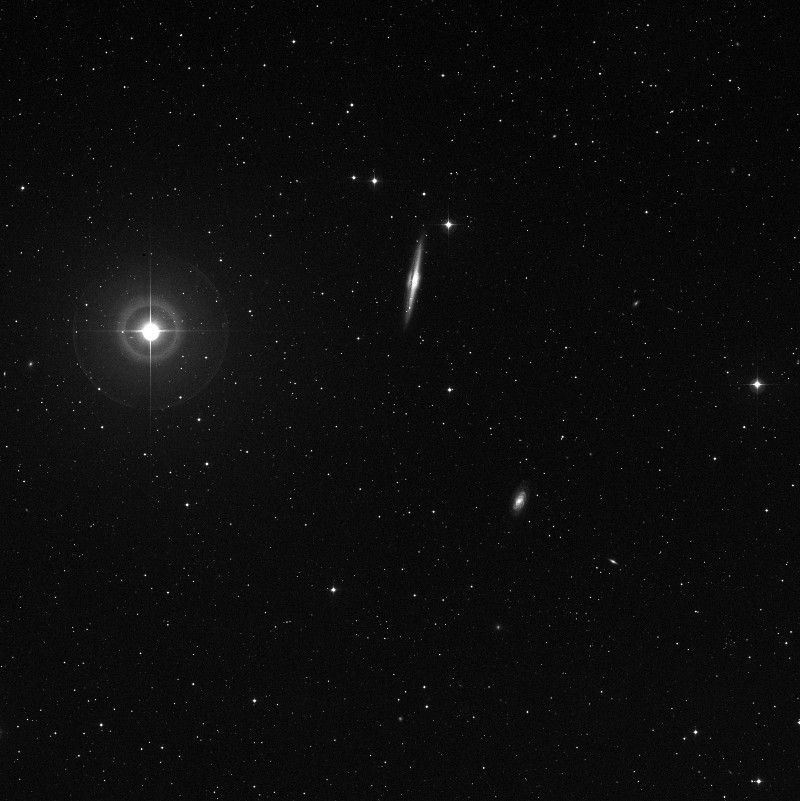
The bright star on the left is 109 Virginis. Elongated galaxy, NGC5746,
and NGC5740 (lower right). The image is 60f wide.
The Digitized Sky Survey copyright © 1994
After identifying 15 galaxies the last deep sky object that came into the
FOV was M5. I met with this splendid globular cluster after a long time
and completed the session.
Tuesday, November 28
The contrast of rainy day and fine has been very clear this month,
and unexpectedly, there were many opportunities to comet hunt. Today was
the seventh comet searching session in November. I headed for an observing
site with an altitude of 360 m above sea level, because the site with the
altitude of some 1000 m was closed due to snow.
Prior to the session, I trained my comet seeker at 24P Schaumasse, but I
could not see the object corresponding to that. I managed to recognize the
comet using Lumicon Comet Filter. Though the image was too faint to spot
it without the filter during the searching session, I might overlook this
comet even if I used the filer. Seiichi Yoshida reported the other day
that 24P was the magnitude of 11.5 with DC = 1. I understood that it is
difficult to find a bright comet with low surface brightness.
At 3:50am local time I temporarily moved my telescope from 24P to an
altitude of 40 degrees above horizon, and started the session. Here I was
in the middle of Virogo Galaxy Group, and many galaxies came into the FOV
one after another with a slight movement of my comet seeker. It was easy
to identify them because I applied SkySafari 5 Pro, nonetheless, it was
troublesome as there were so many of them. The first galaxies I
encountered were NGC4424, 4417 and 4442. The second that was only some two
degrees away from the first one were NGC4469, M49 and@NGC4560, and such a
situation continued for a while. I could not afford to enjoy looking at
and comparing with shape of galaxies. Obviously, I missed some galaxies,
since I spent long time to record galaxies that I identified and the
overlap of the FOV was not enough. Among those what attracted my eye was
an interacting galaxies, NGC4568 and 4567. I saw NGC4564 in the same FOV.
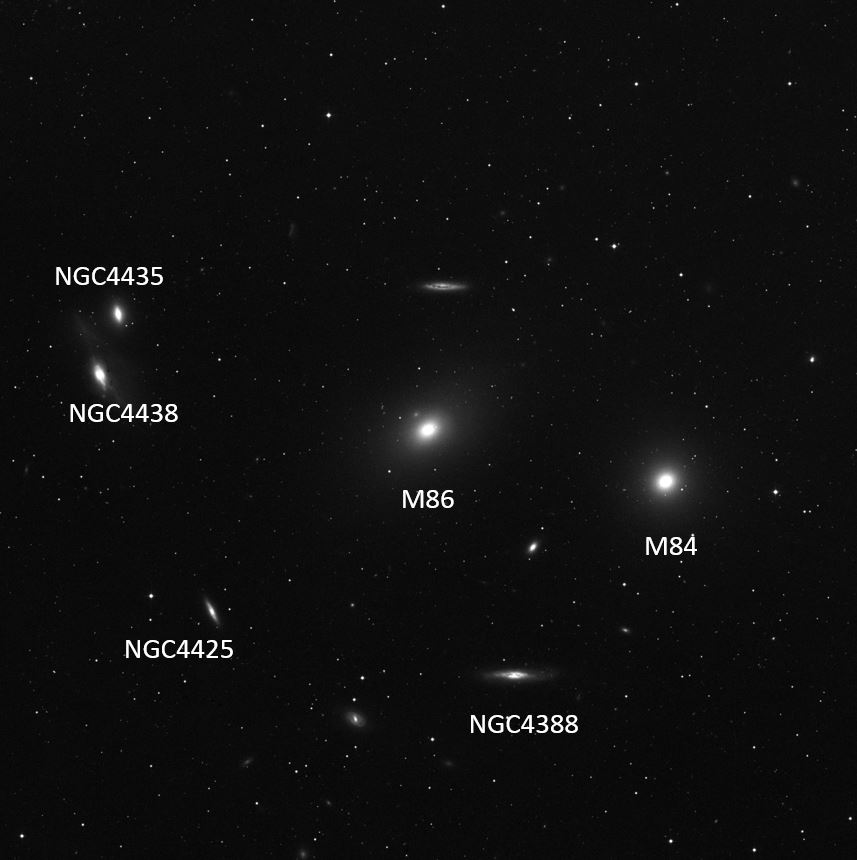
M84, M86 and NGC4438 are part of Markarian's Chain, and the western end of
the chain. I noticed only numbered galaxies in the image during the
session. The image is 60f wide.
The Digitized Sky Survey copyright © 1994
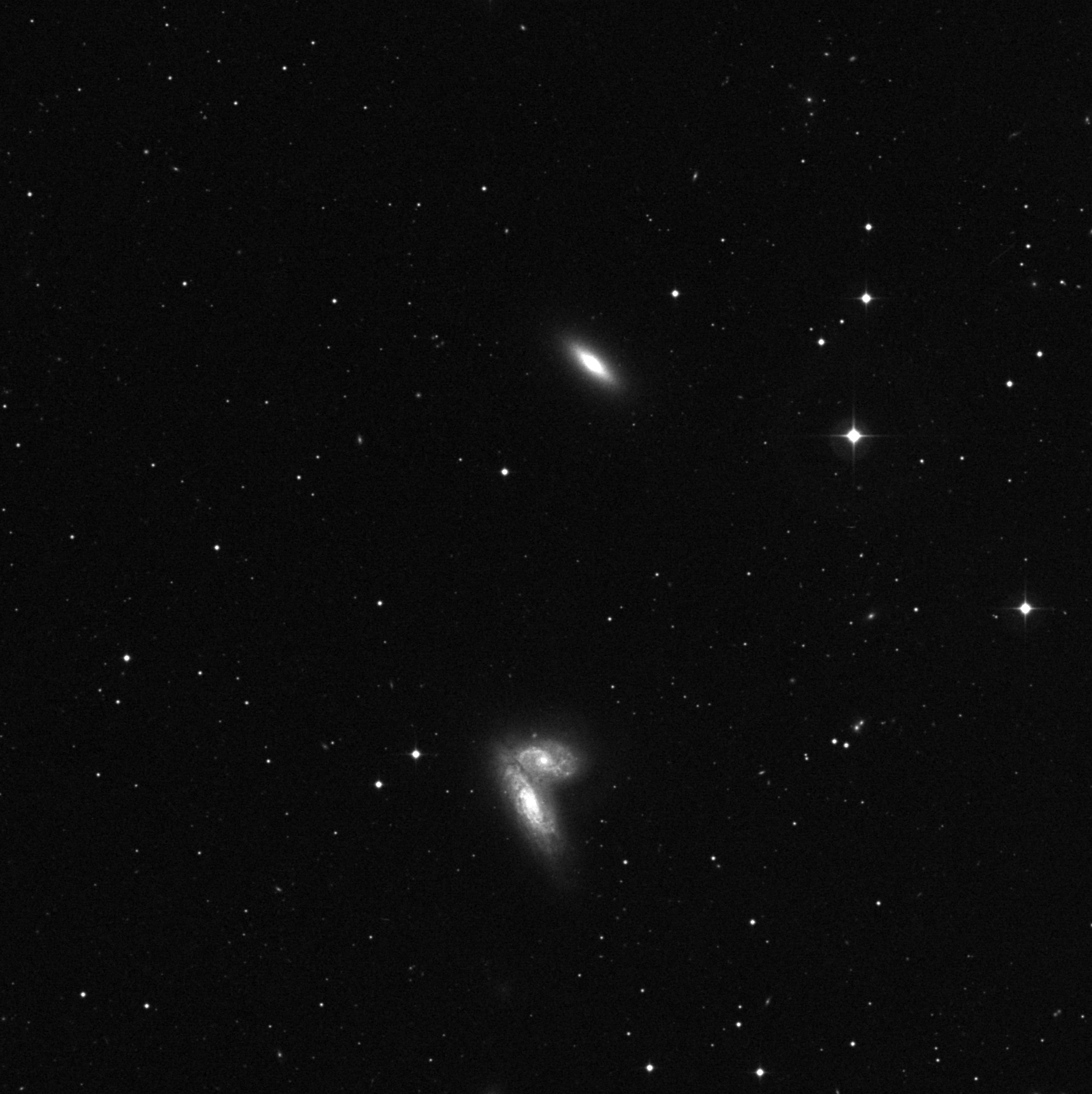
NGC4564 and the interacting galaxies NGC4568-67. The image is 30f wide
The Digitized Sky Survey copyright © 1994
At the begging of the twilight I trained my comet seeker at C/2017 O1
ASASSN, but I could not recognize the come at a glance. I tried again with
an attention but could not. Finally, I saw the comet applying the comet
filter. Seiichi Yoshida observed C/2017 O1 as the magnitude of 11.5 that
was the same with 24P with DC = 2, which showed more condensed than Comet
Schaumasse. For me observing C/2017 O1 was as challenging as that of 24P.
It was almost impossible to spot those comets.
Air temperature was -1 degree Celsius that was not very severe, but my
telescope and polar down jacket turned into white due to frost
condensation.
Monday, November 13
How wonderful this clear predawn was! This was the third comet
hunting session this month, i.e. the first one was Wednesday 1 and the
second was Monday 6. The chill was severe and the air temperature was -2
degrees in Celsius when I arrived at the site at 3am. I found a small
amount of remaining snow at the shade. I began the hunting session at
3:45am because I spent a lot of time to wear winter clothes. There was a
crescent moon at the foot of the constellation of Leo, and I started the
searching session with M3 in the northeast to avoid the moonlight. Under
the moonlight the altitude of M3 was only 13 degrees above the horizon,
but the cluster dissolved into numerous individual stars that proudly
shined.
Todayfs major search area was Canes Venatici where there are uncountable
galaxies. However, I could observe bright ones only due to the moonlight.
The first comet-like object that I encountered was NGC4145 (magnitude of
10.8), which found to be a galaxy at a glance because of the elliptical
shape and a hint of spiral structure. I did not notice NGC4151 that was in
the same FOV with NGC4145.
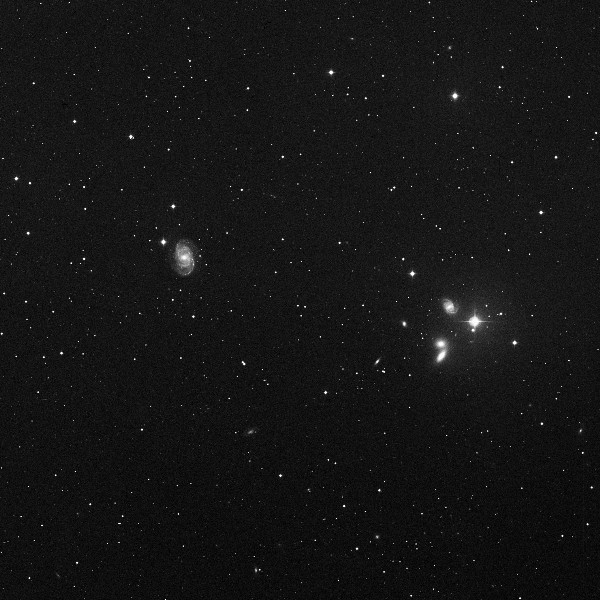
Three galaxies on the left: from the top NGC5350, 5353 and 5354. Left:
NGC5371. The image is 60f wide.
The Digitized Sky Survey copyright © 1994
Soon after the start of the session Cor Caroli, alpha Canum Venaticorum
and a binary star, came into the FOV. The beauty of yellow colored primary
and violet secondary was restful and peaceful, which I drank in for a
while. NGC4490 and 4485 were interactive galaxies and they were deformed
by the gravity of their own. After identified M94, M63, NGC5557 and 5326,
I saw four galaxies, NGC5350, 5353, 5354 and 5371, in the same FOV. I
observed 17 galaxies during the session and the darkest one was the 12th
magnitude, i.e. NGC4326, while I looked over many 10th magnitude galaxies.
The easiness of the detection for comet-like object is dependent on not
only the magnitude but also the surface brightness (the degree of
concentration). Nonetheless, I found myself that both of those factors
cannot explain the cause of the oversight.
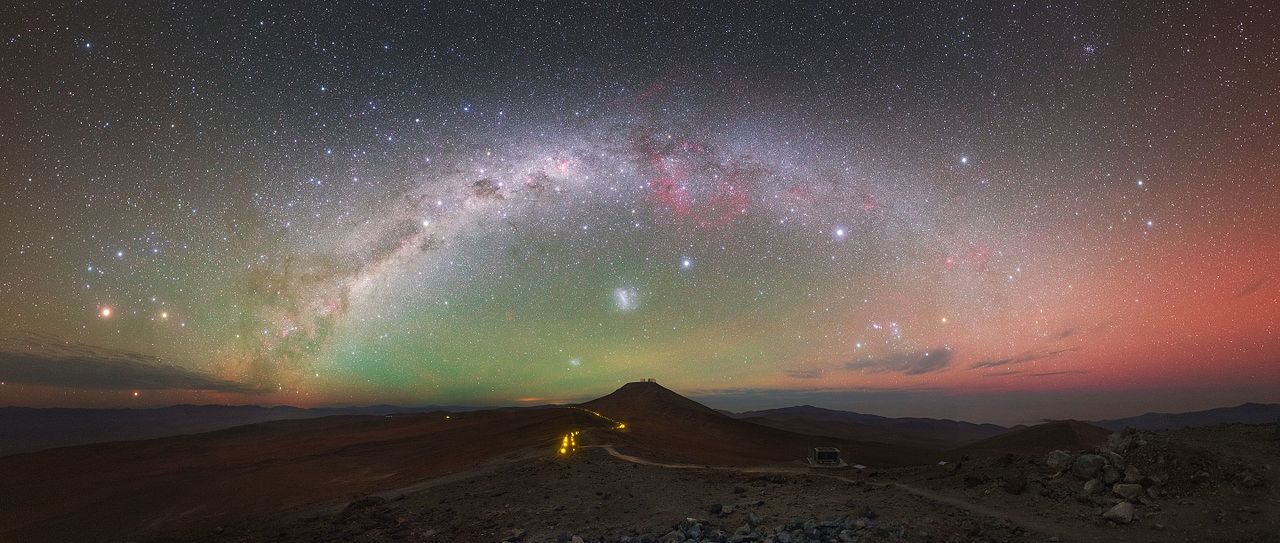
Night glow in Paranal Observatory in Chile. The night glow is
inhomogeneous and stronger at lower altitude of the sky.
http://www.eso.org/public/images/potw1638a/
Tsutomu Seki described in his publication that the cause of overlooking is
mental condition of the comet hunter of the time. Recently, I began to
think that the cause is the effect of night glow. I have often recognized
nonuniform brightness in the FOV of my comet-seeker. It is obvious that it
was not cloud and not a part of a large nebula. It seems that the
nonuniform distribution of night glow affects brightness of the background
that leads to oversight of comet-like objects. On top of that, as the
distribution of night glow varies with time, an object that one could not
observe may be observable after a short period of time.
At the time of the beginning of the twilight when Mars and Spica
roses high above the horizon, the coldness got further severer and the
thermometer on hand indicated -4 degrees Celsius. The daybreak in late
autumn is lovely as temperature went down.
Friday, October 27
It has been rainy and cloudy since October 1 when I conducted the
comet hunting session last. Finally, we had clear sky this predawn. It was
chilly as air temperature at the site with an altitude of 1000 m above sea
level was only 3 degrees Celsius. I started the session with Regulus,
alpha Leo. I began with this star because I could spot 62P Tsuchinshan
soon after the beginning of the session and 28P Shaumasse in the galaxy
groups of Leo if I continued comet hunting toward the north.
However, actually, I had overlooked 62P. I pointed my comet-seeker at the
comet using the SkySafari 5 Pro; 62P was faint and rather difficult to
observe. I thought that the comet passed through at the edge of the FOV
during the sweeping, but I felt something was wrong. I looked over the sky
and noticed that thin cloud covered the entire sky. I could not see 62P
due to the cloud in addition to bright zodiacal light.
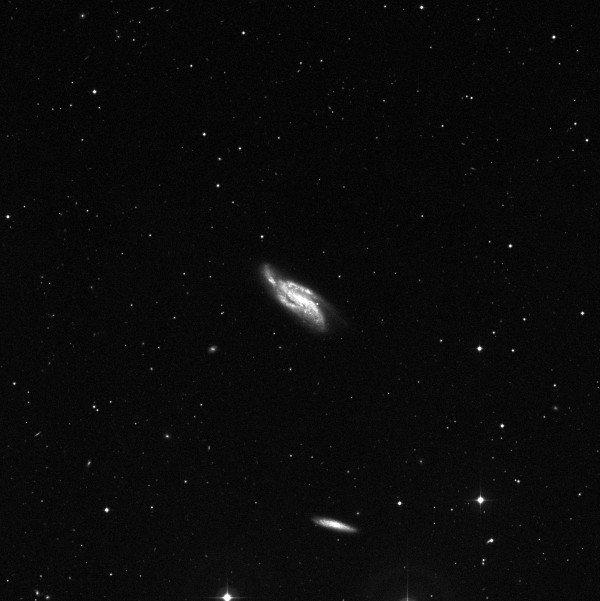
NGC4088 (center) and NGC4085 (lower center). NGC4088 looked like paler
image of this photo. The image is 30f wide.
The Digitized Sky Survey copyright © 1994
At 3:50am almost all the sky was covered with thin cloud. There was a gap
among the clouds in the northeast and I trained my comet-seeker there. I
identified NGC4800, 4026, 4157, 4088 and 4085 in the cloudy sky, but the
break was closed in a short time. Next, I spotted NGC6643 at the north and
the amount of cloud reduced except for the east.
At 4:25am I observed C/2017 O1 ASASSN (9th magnitude, diameter of 6f with
a tail), C/2016 PanSTARRS (13th, 0.5f) and 62P (10th, 4f). I resumed the
hunting session from the positon of 62P, i.e. in the constellation of Leo.
After identifying NGC3641, M95 and M96, I was clouded out again at 4:52am.
At 5:00am I tried to observe 28P through a small break in the clouds, but
23minutes had passed since the beginning of the twilight. I could see
nothing at the positon of the comet, however, I spotted 28P using the
Lumicon comet filter!
It was satisfactorily session, though there were a lot of clouds. When I
was taking down my comet-seeker Venus rose and shined lovely just above
the horizon.
Monday, September 4
It has been nasty weather for exactly one month. When I got back to
my motherfs house in Shiga Prefecture in the middle of August in gObonh,
the sky was clear and we enjoyed watching Saturn and globular clusters.
Contrary, in Tohkamachi, we have had no fine days.
This year there were few cloudless nights even if the forecast predicted
fine weather. I did not expect clear sky this predawn, but when I got up I
found starry sky out there that seemed to be miracle for me. As I planned
I conducted the comet hunting session at the farmland behind my residence,
because there was little expectation for fine weather and did not get up
early. The moonset was 2:57am local time and the start of the twilight was
3:48am, which meant the dark night was only 51 minutes. I went out and set
up my comet-seeker quickly, and I could begin to searching at 3:10am.
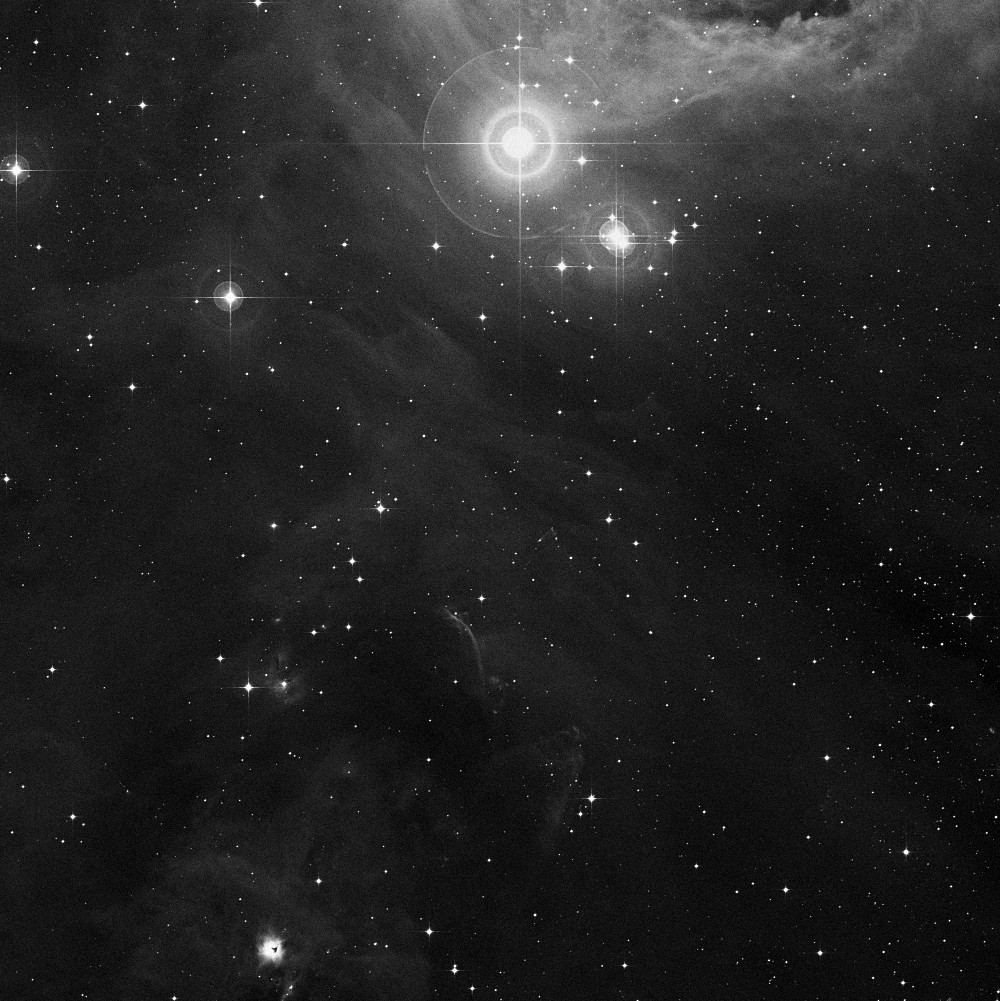
NGC1999 (lower left) and the southern part of M42 (upper right).
The image is 60f wide. The Digitized Sky Survey copyright © 1994
The constellation of Orion rose rather high above the horizon when I
started the session. I thought that the area along the ecliptic must be
swept by the comet hunters all over the world, and I dared to begin with
Orion that is away from the ecliptic. Unintentionally, I trained my
telescope on the constellation of Orion, and I peered into the FOV.
Accidentally, I noticed there was an object that looked like a reflection
nebula. I identified the object using the SkySafari 5 Pro, and it turned
out to be NGC1999. At the same time I saw a nebula drawing a large arc on
the northwest of NGC1999, and I moved my comet-seeker to the nebula. I
found it to be M42. The arc was the loop-shaped area of the southern part
of M42. At home I learned that NGC1999 has a gholeh at the center, and I
remembered that I was sure to have observed the hole with a high
magnification in the past.
I continued the session and the Orionfs Belt came into the FOV. I could
see the Horsehead nebula with conscious observation, not to mention
NGC2024 (Flame nebula). NGC2167 in Monoceros seemed to be a reflection
nebula. A star was surrounded by a faint nebula. The winter Milky Way
around the region was beautiful. The next object that came into the FOV
was M78 and I also noticed NGC2071 that is near M78.
I spent for one hour and ten minutes for todayfs session, and completed
when Venus rose high in the sky. The site was behind my house but I
observed the winter Milky Way at 20 degrees or higher above the horizon
that meant the transparency was pretty good. I was content with the
hunting session for the first time in a while.
Friday, August 4
I got up at 0:40am and looked at the sky. The amount of cloud was
40%, but transparency was good. I headed for the observing site but on my
way to the site I noticed that it seemed to be cloudy. I parked my car and
confirmed the sky condition: I could see only a few stars. I did not
expect to conduct a hunting session satisfactorily, but anyway I drove to
the site.
I completed setting up my comet-seeker before 2am, but only one star was
in the sky to align the digital setting circles (DSC): when Capella
appeared Polaris was hidden by a cloud, and both Capella and Aldebaran got
behind a cloud when Polaris was shining. I was patient and finally, I
could finished the alignment of the DSC at 2:20am.
At 2:22am I observed C/2015 ER61 PanSTRRS. The magnitude was 11th with a
diameter of 1.5f. It looked much darker than actual brightness since I
observed the comet through thin cloud. I saw C/2017 O1 ASASSN1 for the
first time: mag. 10 and diameter of 8f. The comet had large apparent
diameter like Comet Ikeya-Murakami upon discovery with darker brightness.
There were breaks of clouds in the direction of those two comets but they
disappeared behind clouds soon. I started the comet hunting session;
wherever there was a gap of cloud I trained my comet-seeker and swept. I
could not concentrate on the session because the amount of cloud was 80 to
90% and the breaks of clouds were filled soon. I was forced to sweep the
other part of the sky.
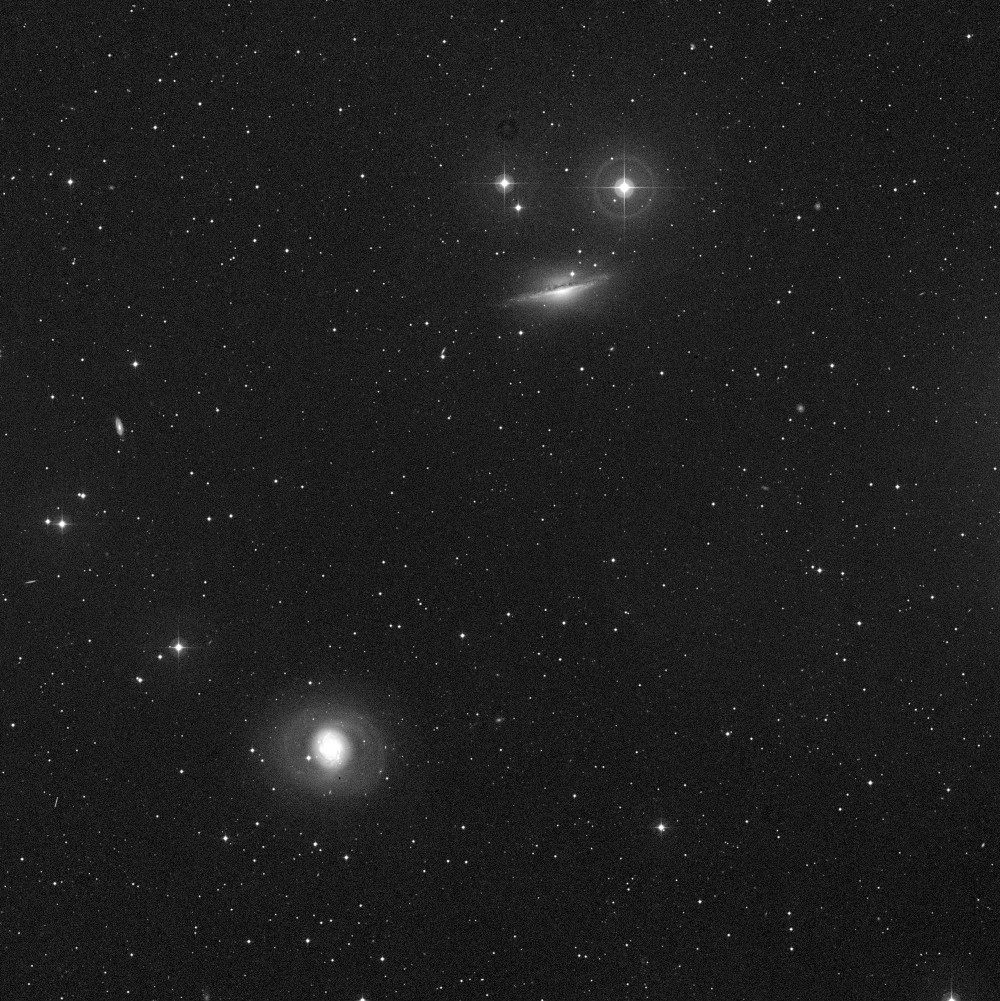
M77 (lower left) and GC1055. I could have noticed the dark lane of
NGC1055, if I had carefully observed.
The image is 60f wide. The Digitized Sky Survey copyright © 1994
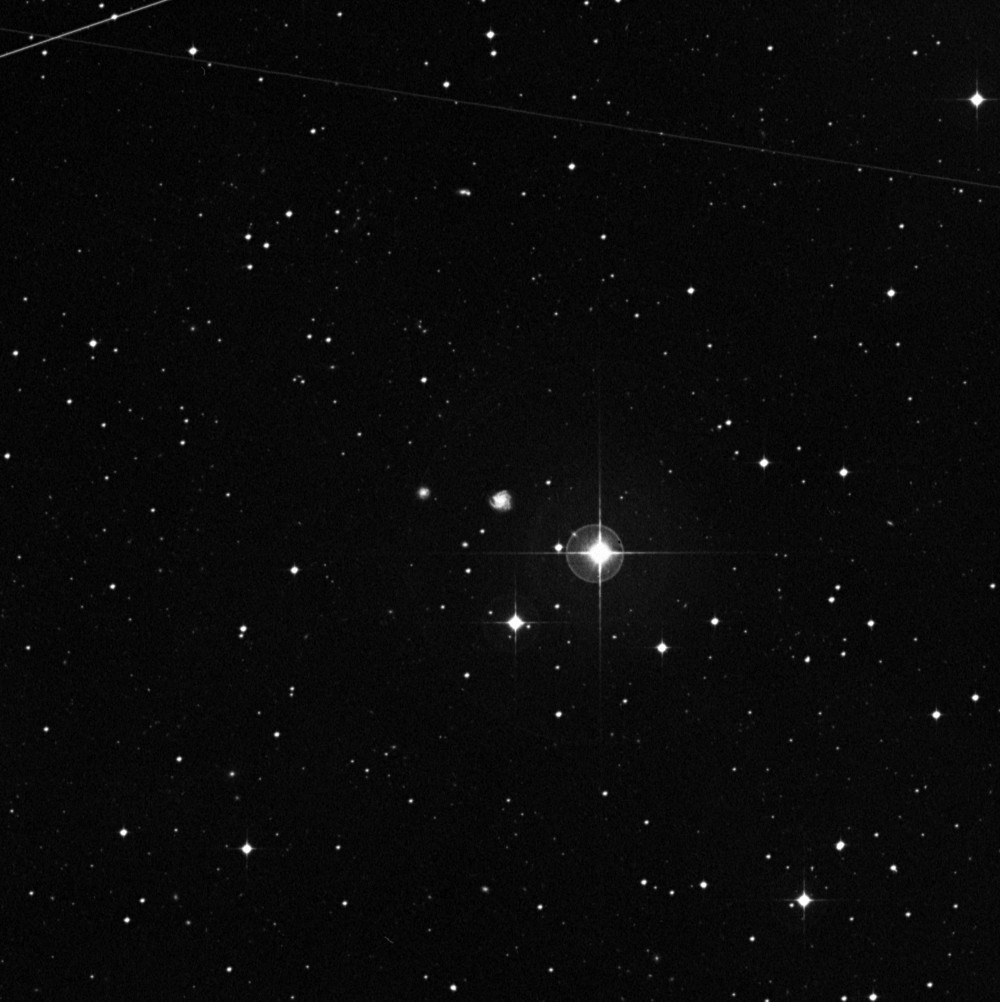
NGC1363, a small galaxy (center). The image is 30f wide.
The Digitized Sky Survey copyright © 1994
At 2:55am I observed C/2017 O1 again as the cloud around the comet
disappeared. Without a filter it looked the same as I observed at 2:30am.
But with the Comet filter the comet had a coma 5f in diameter with a tail
3f in length. The sky got completely cloudless straightaway and I aimed my
telescope higher altitude. M77 and NGC1055 came into the FOV. I saw faint
halo surrounding the nuclear of M77. After that I identified NGC1087,
1090, 1421 and 1337. I compared the actual FOV with SkySafari 5 Pro to
confirm the function of the encoders that I tuned the other day, and accidentally noticed that NGC1363 was in SkySafari 5
Pro. In the actual FOV I found NGC1363 with ease. The data indicates the
galaxy has a magnitude of 13.1 with an apparent diameter of 0.9f, however,
the diameter was 0.3f visually that makes it impossible to spot the small
galaxy during a hunting session. The sky have been cloudless until when I
completed the session at 3:45am. The clear sky lasted only less than one
hour, but I was content with a grareh sky condition that I finally met.
Saturday, July 22
Bad weather
I feel there is a trend of bad weather in the past few years, and
transparency is poor even if it is fine. I did not confirm the trend based
on the statistical analysis, but some comet hunters told me that they had
the same impression. I comet hunted last on June 20, i.e. I could not
comet search for more than one month because of nasty weather; if it was
cloud less, I could not search due to poor transparency.
Three photos below are taken from my house. From top to bottom Dec. 30 in
2013 (fair with good transparency), Jun. 1 in 2014 (fair with poor
transparency due to yellow sand from the continent), and Jul. 22 in 2017
(cloudy with poor transparency probably due to high concentration in
aerosol). In the photo taken in 2013 a mountain range 30 km away from my
house is clear (indicated by a square), contrarily, it is not visible in
the other photos.

Dec. 30 in 2013 (fair with good transparency)

Jun. 1 in 2014 (fair with poor transparency due to yellow sand from the
continent)

Jul. 22 in 2017 (cloudy with poor transparency probably due to high
concentration in aerosol).
I exactly do not know the reason why the increasing trend of the days with
poor transparency, but I think the concentration of aerosol is getting
higher for unknown reasons. The web site below can simulate some different
kinds of aerosol concentrations and may give clue for this topic.
http://sprintars.riam.kyushu-u.ac.jp/forecast2.html
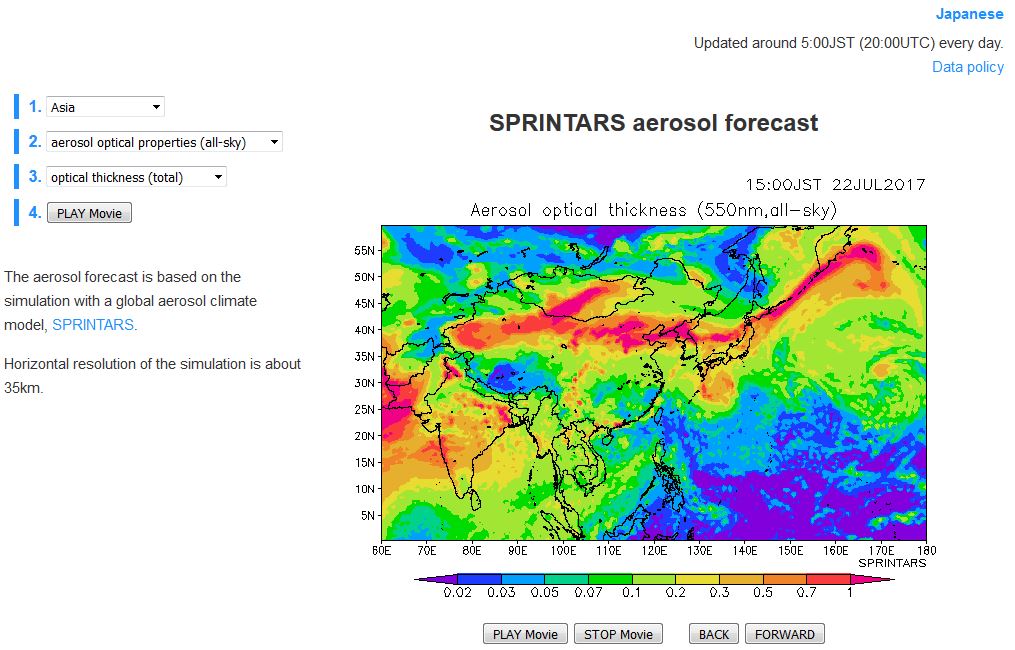
Aerosol forecast at 15:00 JST, on 21 Jul. 2017
Improvement of 46 cm comet-seeker
Last year I replaced the focuser of 46 cm comet-seeker because it was
broken. The old one was light weight but made by plastic: the Phase 4,
AstroSystems, CO, USA. From the beginning I was afraid the durability but
was satisfied with the product since it worked well for 15 years. Please
refer to this page on the
series of improvement of my come-seeker.
The pole seats and the wedge method was used to connect the truss poles
and the top ring (secondary cage), however, there was a defect that the
alignment shifted at an altitude of over 60 degrees. Also, the method
requires long screwing length that is a bit annoying. To solve those
defects I adopted the crush-tube method. One end of the pole was crushed
in 10 cm long and overlapped poles are fixed by the bolt and nut. Along
with it the insulator that covers the poles was also replaced with the new
one: from thick one for water pipe to thin black one. The alignment was
improved but not perfect and it seems to shift a bit over 70 degrees in
altitude. After the improvement there is no clear sky. Now it is rainy
season, but I am looking forward to clear sky with high transparency after
the end of the rainy season.
Monday, June 5
I conducted comet hunting sessions seven times in May, but I could
not satisfied with them all because of poor sky conditions: moonlight and
hazy air. Today the moon set at 2:03am and the twilight began at 2:35am,
therefore, the dark night lasted only some 30 minutes. However, the
transparency was fair and I expected pleasing session. I wondered if how
many galaxies I could identify during the session around the Great Square
of Pegasus.

NGC7769, 7770, 7771. The image is 30f wide.
The Digitized Sky Survey copyright © 1994
I began with the session from Markab, alpha Pegasi, at 1:55am. Air
temperature was 4 degrees in Celsius that was low at this time of the
year, though the site is over 900 m above sea level. Soon after the start
of the session, the first galaxy of this session, NGC7743 (mag. 11.4) had
come into the FOV. An owl hooted as if it had announced there was still
some time until the beginning of the twilight. When the twilight started I
identified the second galaxy, NGC7678 (11.8). I was somewhat disappointed
because I could not observe many galaxies as I expected. Nonetheless,
NGC7769 (12.0) and 7771 (12.1) were came into the FOV at 2:49am. The
SkySafari 5 Pro indicated another galaxy, NGC7770 (13.6) near NGC7771. I
looked at the positon and I easily noticed NGC7770. I was glad I could
identified those galaxies with an altitude of 20 degrees, but I had no
idea why I did not notice the other 11th magnitude galaxies within the
search area. I overlooked even 10th magnitude one, NGC7814. I think this
was probably due to the low altitude and small apparent diameter of the
objects. I always have doubts like this, and I wonder if the capability of
my comet-seeker is not enough to detect dark objects considering the
aperture.
After 36 minutes of the start of the twilight, C/2015 ER61 PanSTARRS have
come into the FOV. The comet had a tail with the magnitude of 8th. I
continued the session and finished when Venus was in the FOV. A cuckoos
chirped in replace with the owl. What a fresh daybreak! Air temperature
dropped to 2 degrees in Celsius.
Tuesday, May 2 and Wednesday, May 3
I conducted comet hunting session three times in April, but I
updated my web page only once on April 1, because I had been very busy.
One of the reasons was that I have been in Vienna to take part in General
Assembly of European Geosciences Union (EGU) as a forest hydrologist not
as an amateur astronomer.

Venue of EGU in Vienna.
I took off on Monday, May 1, to recover from the jet lag. I tried to go to
the observing site for non-snow season without expecting disappearance of
snow. I could not go beyond the point with the altitude of 600 m due to
snow cover. As the altitude of the site is 962 m, it probably takes one
more week until the disappearance of snow. I use the temporal observing
site with the altitude of 575 m until the snowmelt of the summer site.
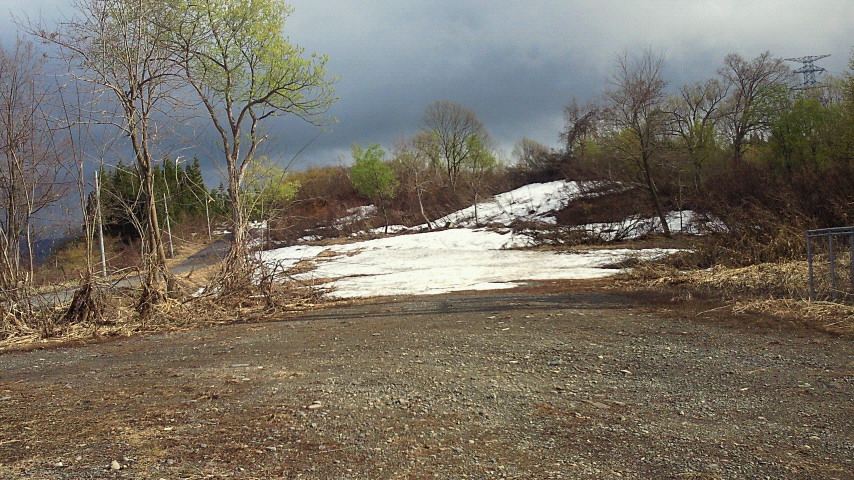
The observing site with the altitude of 575 m where there remained some
snow cover on May 1, 2017.
Tuesday
I was scheduled to get up at 1am, but I wake up at 0am because of the jet
lag. I felt I could not sleep anymore, and I headed for the site. I was
ready to observe at 1am. Prior to the comet hunting session, I enjoyed
observing bright comets. Comet 41P Tuttle-Giacobini-Kresak was 7th
magnitude, DC = 2, diffused, and the wide tail was not distinct with the
length of 0.1 degrees. I could recognized the existence of the comet using
a 7x50 binocular. C/2015 V1 Johnson was 6th magnitude, DC = 4, the
beautiful tail extended as long as 0.7 degrees. I noticed the tail with
ease using the 7x50 binocular. The brightness of these comets were
determined by intuition and not objective.
I started the comet hunting session from the east at 1:20am, specifically
from Altair, because the southeastern sky was very bright. I wondered what
the source of the light pollution was. Did a ski resort still open through
the night? I noticed the southeast is always bright at this time of the
year. During the session the DSOs that I identified were NGC6934, M2,
NGC7006, M15 and NGC7177. All of them except for the last one were
globular clusters. I identified NGC7177 (mag. 11.2) when it was at the
altitude 39 degrees 15 minutes after the beginning of the twilight.
Nonetheless, the impressive moment for me at the session was when C/2015
V1 Johnson came into the FOV. I noticed that the object was the comet in a
moment. Spotting a comet, even if it is a known one, gives me an
inspiration.
I often come across wonderful double stars during the session, but I have
seldom confirmed the names. During this session, I identified a double
star. It was Gamma Delphini. The primary star was golden with the
secondary being dull golden. I checked the color of them at home using the
Internet; the primary was golden as I observed, but the secondary was
unexpectedly light blue. The golden color of the primary looked like that
of Golden Hall, Musikverein in Vienna where my wife and I enjoyed the
concert. I wondered how long the star has been shining. In comparison with
the period, the lifetime of the Hall must be as short as a blink of an
eye.

Golden Hall, Musikverein in Vienna.
Wednesday
Following yesterdayfs session, I conducted one this predawn also. I began
with NGC7177 that was the last DSO I identified yesterday. This galaxy
looked a mere faint stain because of poor transparency. During the session
I identified Veil Nebula in Cygnus. Last year I installed a filter slider
on the focuser on which three filters are attached: IDAS LPS-P2, Lumicon
Comet, Lumicon OIII. The nebula was not clear due to haze but applying the
Comet or OIII filter improved the contrast dramatically and made the image
wonderful.
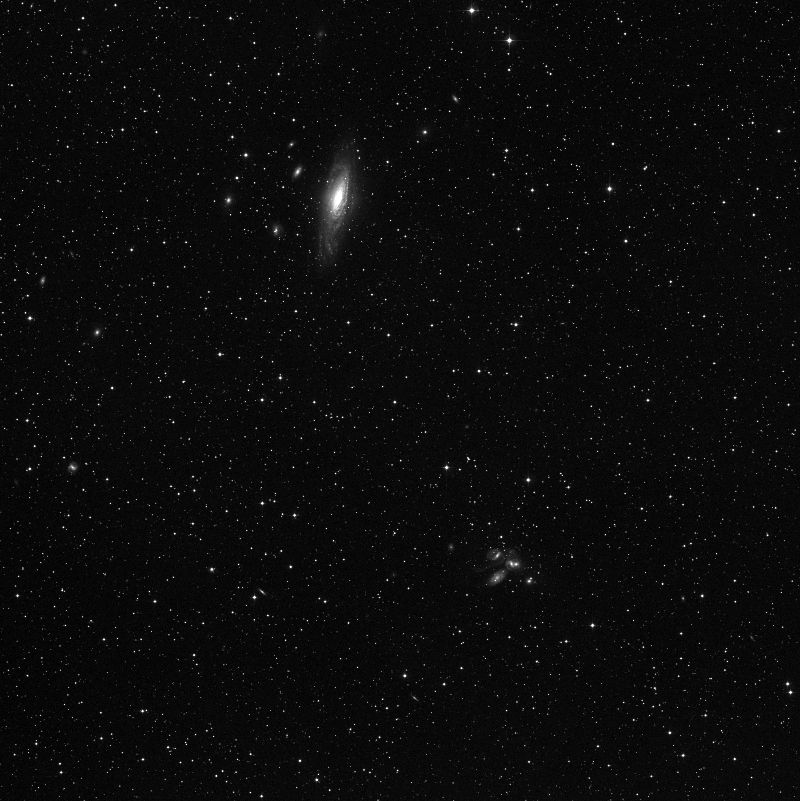
NGC7311 (upper center) and Stephanfs Quintet (lower right).
The Digitized Sky Survey copyright © 1994
There are many galaxies in the constellation of Pegasus, the major search
area today, however, I encountered only two, NGC7217 and 7331, except for
NGC7177 from which I started the session. NGC7177 came into the FOV
following 10 minutes of the start of the twilight. I could manage to
recognize Stephan's Quintet that is 0.5 degrees south southeast of NGC7331
with attention. In the latter half of the searching session, the
transparency got worse with time and hazy. I completed the session when
Venus rose on the eastern horizon.
Saturday, April 1
We have had no clear sky at predawn for just four weeks. During the
period I got up at predawn a couple of times, but I was clouded out.
I went to skiing and on a hiking to a snow-covered mountain last month. It
takes some 15 minutes by car to Joetsu Kokusai Ski Resort where one of the
nearest ski field from my residence. At the top of the field air
temperature was below zero degree Celsius and snow quality was pretty
good. At the lower part, however, snow was granular and poor quality with
few skiers.

The highest point of Joetsu Kokusai Ski Resort. It was snowing in the
morning.
The hiking course was Mt. Sakato-yama (37.059034N, 138.898435E ) where I
usually enjoy mountaineering. It is 30minutes drive from my house to the
parking at the foot of the mountain where 165 m above sea level (a.s.l.).
For me it is 50 minutes-walk (in summer 40 minutes) from the parking to
the top (634 m a.s.l.). On Monday, March 20 the snow depth at the parking
where many city houses were was around 1 m, while at the top 2 m.
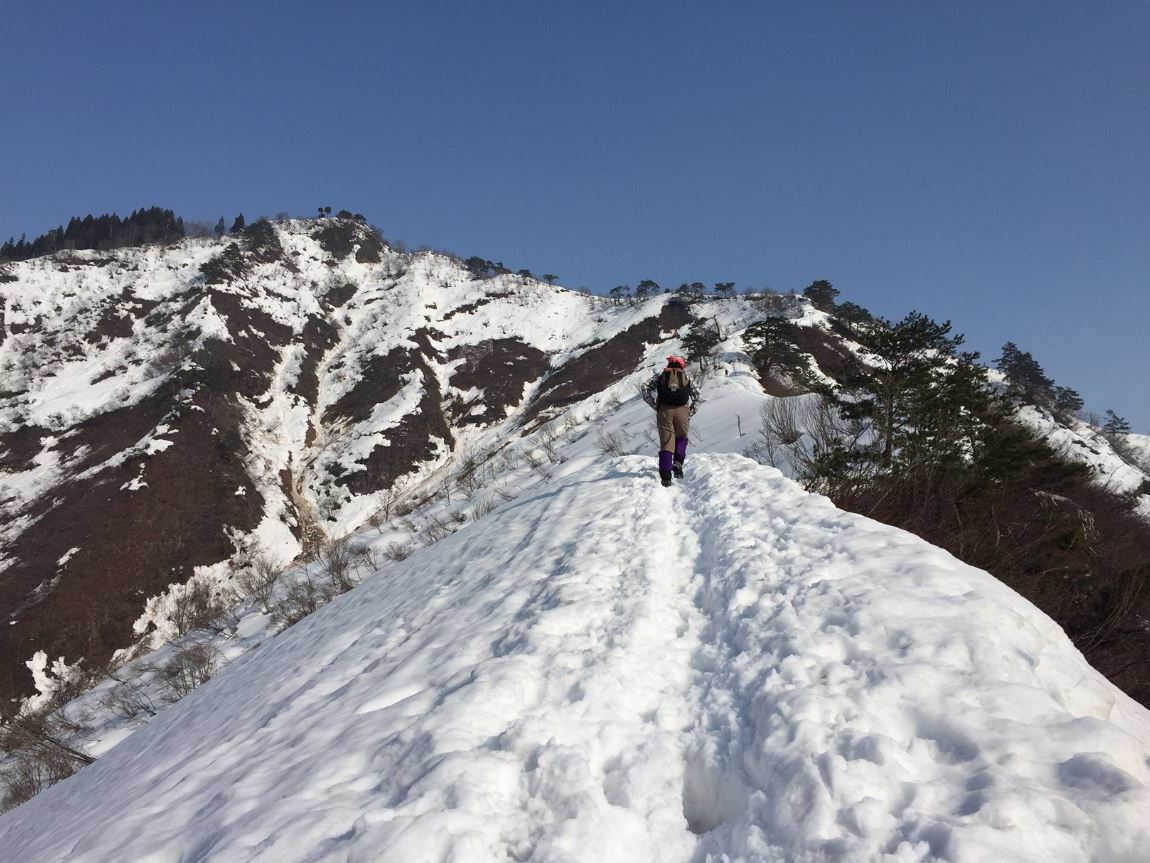
Toward the top to the Mt. Sakato-yama. It was cloudy in the morning.
After getting back to the parking from the top I saw a wonderful scene
that the top of the mountain and houses were reflected on the surface of a
pond. It was refreshing and looked like European one. One month has
passed since I observed 41P/Tuttle-Giacobini-Kresak last. I have yet
spotted C/2017 E4 Lovejoy nor C/2017 E1 Borisov. All of them are getting
brighter. I hope clear skies in Apirl.

Mt. Satato-yama (a peak at upper center).
Tuesday, February 28, Wednesday, March 1, and Saturday, 4
At predawn we had clear sky three out of five days. I must say it
is rare that we have gso manyh clear days at this time of the year.
Tuesday, February 28
Air temperature reached as low as -7˚C that was the lowest record in my
comet hunting session this winter.
Prior to the session I observed 45P/Honda-Mrkos-Pajdusakova,
41P/Tuttle-Giacobini-Kresak and C/2015 V2 Johnson. This is the first
observation of 41P and 45P for those returns. The image of 45P was
extremely diffused and it looked like M33 under a bit poor sky condition.
With careful observation I noticed the comet had the west ward tail with a
length of 0.6˚. I estimated the parameters of the comet as DC=0, dia. >
10f, and mag. 8th by intuition. Another periodic comet, 41P has a tail
with 11th magnitude. The tail of C/2015 V2 got wider in comparison with
that on January 7, and the magnitude of the comet was 11th. It is
interesting that each comet had its own trait.
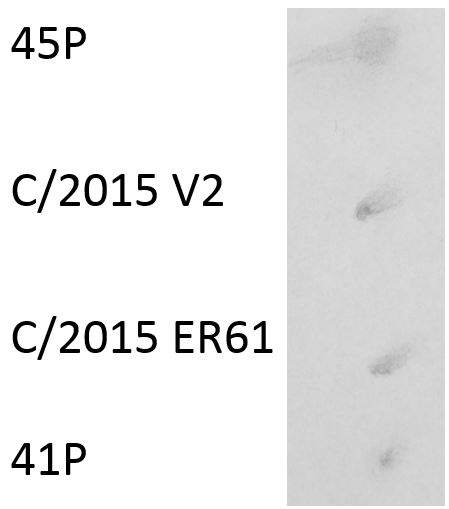
45P/Honda-Mrkos-Pajdusakova, C/2015 V2 Johnson,
41P/Tuttle-Giacobini-Kresak and C/2015 ER61 PanSTARRS. The drawings were
made at home after the observation based on recollections.
I began the session with M4, a globular cluster in Scorpius, and finally,
I identified 18 DSOs. The catalog data of NGC6325, a globular cluster,
shows the magnitude is 10.5 with apparent diameter of 4f, but for me it
looked 12th magnitude with the diameter of 1f that was faint enough to
have had been overlooked. After the start of the twilight, I trained my
comet-seeker at C/2015 ER61 PanSTARRS. When I observed the comet on
January 22, I could not recognized it without a filter, and I managed to
observe the comet with the comet
filter. After observing C/2015 ER61, I made a 10-minute searching
identifying 3 globular clusters, and completed the session at 5:18amlocal
time. The last globular cluster that came into the FOV was NGC6401 in the
vicinity of Saturn but Saturn was out of the search area.
Wednesday, March 1
It was as chilly as yesterday with the air temperature of -6˚C. I started
the session with Eta Ophiuchi so that the search area overlapped with that
of the previous day. When M9 came into the FOV I looked at SkySafari 5 Pro
and noticed that there is a dark nebula in the vicinity of the globular
cluster. Again I peered into the FOV and actually, there it was; the
number density of stars are different between the right and left side of
M9.
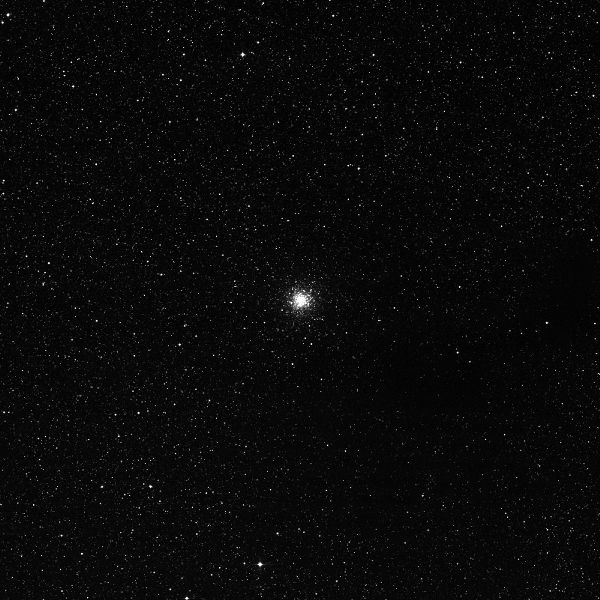
M9, a globular cluster in the constellation of Ophiuchus. There is a dark
nebula on the lower right. The image is 1 degree wide.
The Digitized Sky Survey copyright © 1994
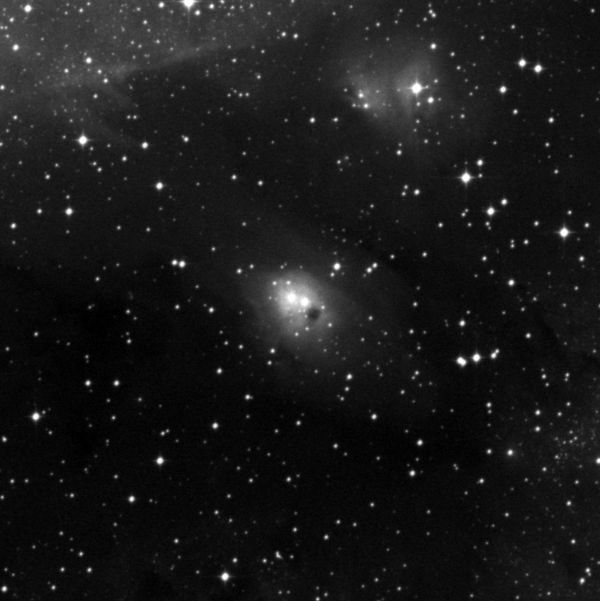
An emission nebula in Sagittarius, NGC6595. The image is 15f
wide.
The Digitized Sky Survey copyright © 1994
I could identified an emission nebula, NGC6595, because I saw a faint blur
of light around a double star. Showpieces of DSOs like M22 and M17 went
through the FOV with the gorgeous background of stars. I finished the
session with wonderful view of those objects.
Saturday, March 4
On weekends the light pollution is getting prominent at the usual
observing site. This is because Kandatsu Kogen Ski Resort, some 18 km
away, opens through the night.

Advertising of all night opening of Kandatsu Kogen Ski Resort.
http://www.snowjapan.com/japan-ski-resorts/kandatsu-kogen
The service finishes at 4am local time, but the light at the ski field
remains crazy bright after the time. In the past the resort was once
closed because it went bankruptcy and the managements have changed a few
times. Now, it features the service of all night, but it is annoying for
me. I headed to the observing site that was different from usual one to
avoid the light pollution caused by the resort. At the usual site the
direction of the pollution is on the southeast but at todayfs site on the
south-southeast.
I began with M17 to overlap the sweep area with that of 3 days ago.
However, around 10 minutes later, I was discouraged by the light pollution
originated at the ski resort that made the FOV bright. I recovered from
the negative sense and I resumed on the east where less polluted. A
globular cluster NGC6760 and two planetary nebulae, NGC6781 and 6804 have
come across the FOV. NGC6781 is worth observing 11th magnitude nebula with
an apparent diameter of 2f. On the contrary, the 12th magnitude nebula,
NGC6401, has the apparent diameter of only 0.5f. I could noticed NGC6401
as I employed the magnification of 97. If I used 68x or 78x as I did in
the past, I would have overlooked NGC6401.
In snow season, light pollution from ski resorts in addition to snow light
makes the sky brighter. Another disadvantage in winter is that I cannot go
for the site with high altitude due to snow. I am longing for
disappearance of snow.
Sunday, February 5
When I arrived at the observing site at 2:10am local time, air temperature
was -2˚C. It was not very chilly. The transparency was inferior, and a
shine of Scorpius that began to rise on the eastern sky looked very weak
probably because of the poor transparency. Light pollution caused by ski
fields around the site made the situation worse.
At the comet hunting session on Friday, Jan. 20, transparency was very bad
and the moonlight boosted the light pollution. On top of that, there was a
large amount of clouds and I could not concentrated on the session. On
Sunday, Jan. 22, wind got stronger with time, which caused snow drifting.
I was forced to stop the comet hunting session in 50 minutes. Snow
drifting is a phenomenon that snow particles on the surface of the snow
cover are blown and drifted by wind. I found more than 100 snow particles
on the surface of the primary mirror upon taking down of my comet-seeker.
Snow particles did not melt as air temperature was -6˚C. I could even blow
them using a rubber bulb dust blower. Having said so, I quitted removing
them because so many particles were on the mirror. I decided to leave the
mirror in the mirror case to sublimate them. I have experienced such a
situation once per winter more or less.
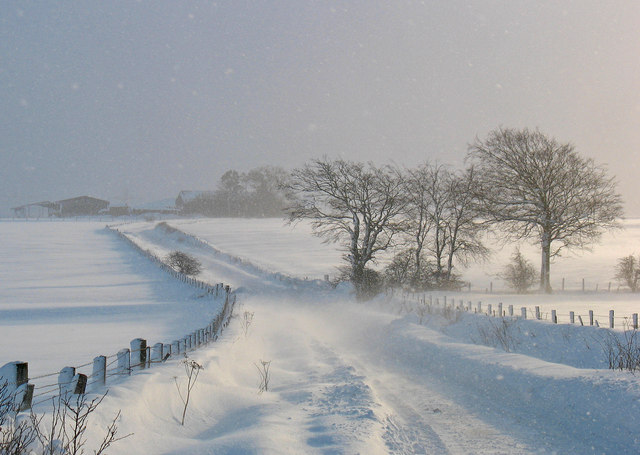
Snow drifting. Even if the sky is clear, snow particles on the snow cover
are blown that causes poor visibility.
© Copyright William Starkey@http://www.geograph.org.uk/photo/2182100
Today transparency was not good just like Friday, Jan. 20, but cloud cover
was less. I began the session with theta Centauri on the southeast to
avoid the light pollution originated by ski resorts in the southeast. The
transparency got worse as time went that made a contrast in the FOV poor.
At 4:34am NGC5728, an 11th magnitude galaxy in Libra, was in the FOV.
Because of bright background the image of the object was faint that might
be overlooked. However, surprisingly, the transparency improved
drastically at around 4:50am local time. Scorpius that was high in the
eastern sky shined vividly. I had an illusion as if I had moved to another
dark site, since the change in the sky condition occurred within a few
minutes.
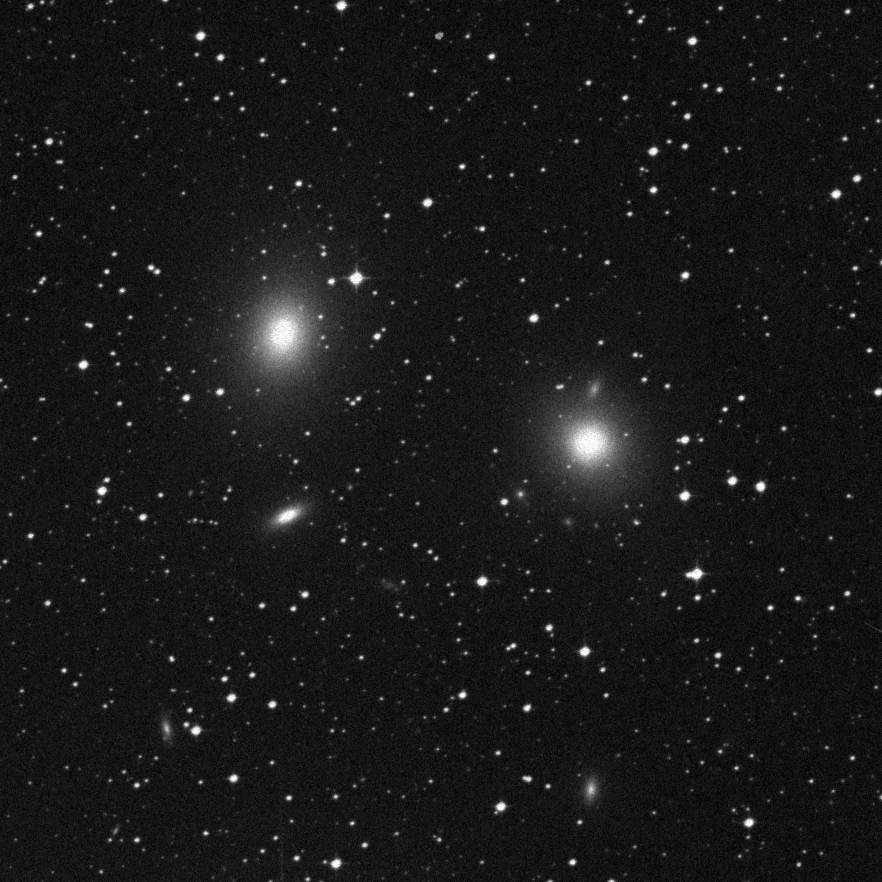
A pair of galaxies in Libra, NGC5898 (right) and NGC5903. The image is 15f
wide.
The Digitized Sky Survey copyright © 1994
After that, the DSOs that came into the FOV were NGC5834 (globular
cluster), a pair of galaxies NGC5898 and 5903, 5897 (g. c.), 5986 (g.c.),
6072 (planetary nebula), M80, and M4. All of them were 11th magnitude or
brighter, and I could not identified darker galaxies in Libra, i.e. 12th
magnitude or darker, at all. My observing site at the snowy season is 425
m above sea level, while 960 m in none snowy season. In addition to the
altitudinal difference, snow light and the light pollution of the ski
fields degrade the limiting magnitude in winter.

Weekly forecast. Japan Meteorology Agency
http://www.jma.go.jp/en/week/323.html
In January and February it is lucky enough in my city if we can conduct
comet hunting sessions two days per month, and in that sense it was a
satisfactorily winter session today. It is expected that bad weather will
last through one week from now on.
Saturday, January 7 and Sunday, January 8
Saturday
A weather forecast said clear sky at predawn, while another predicted
cloudy. I believed clear sky and got out of my bed in the wee hours, but
the entire sky was covered with the clouds and I could not see any stars
at home. Even so, I drove to the observing site expecting starry sky at
predawn.
Upon arriving at the site at 3:05a.m. local time, I saw some stars through
breaks in the clouds. Under the air temperature of | 6˚C it took much time
to wear my polar shoes and clothes. At 3:50a.m. I was ready to observe but
I could not align Nexus DSC, because stars to align with were invisible
behind the clouds. At 3:55a.m. Spica and Arcturus appeared from the breaks
in the clouds and I could manage to align the DSC. There was a band shaped
gap of the clouds at an altitude of 5˚ to 20˚ above the horizon between
the southeast and the south and I swept the area, though 90% of the entire
sky was hidden by the clouds. I identified IC4296, a 10th magnitude galaxy
in the constellation of Centaurus, but the other galaxies nearby were not
observed due to drifting thin clouds. In 20 minutes the area was behind
the clouds, and I turned my comet-seeker some 10 degrees eastward to last
the hunting session.
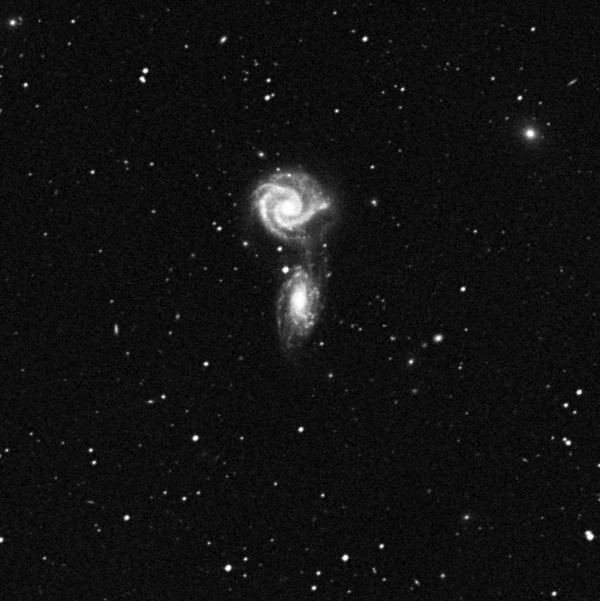
Interactive galaxies NGC5426 (lower galaxy) and 5427. The image is 15f
wide.
The Digitized Sky Survey copyright © 1994
At 5:06a.m. an interacting galaxies in Virgo NGC5426 (mag. 12.1) and 5427
(11.4) came into the FOV. Both of them are spiral galaxies but I could not
see the structure. It may be perceived when they rise higher in the sky.
The amount of clouds declined with time, but it was kept more than 60%
through the session. That meant when I swept the sky from the altitude of
40˚ to the horizon I could see the star less than half of the path and the
rest of the sky was cloudy.
I stopped the session for a while and observed C/2015 V1 Johnson. I saw
this comet for the first time. It was 11th magnitude with a tail of 2f
long, which looked a typical beautiful gcometh shape. At 5:30a.m. I turned
my comet-seeker at C/2016 U1 NEOWISE. The altitude was only 5˚ above the
horizon. It was a 7th magnitude having a short tail of 1f. I have observed
the comet on 25 November for the first time: 13th magnitude with a
diameter of 2f. It got surprisingly bright since then. After observing the
come I completed the 2-hour of session.
Sunday
In a sharp contrast with yesterdayfs sky, the sky was cloudless today.
Having said so, transparency was poor and C/2015 V1 looked as if it had
reduced the brightness by one magnitude, though the actual magnitude must
be unchanged.
The light pollution from the Ski Resort in the direction of Naeba
was not very conspicuous yesterday. Contrary, it was boosted by aerosols,
the causative agent of poor transparency in the form of particulates, and
the entire eastern sky was polluted. I started the session with M5 to
avoid light polluted area, i.e. the southeast. In 10 minutes I applied the
light pollution filter, IDAS LPS-P2, to improve the contrast in the FOV.
The DSOs I identified were M12, M10 and M14 only. In the area I searched
there are some 11th magnitude of galaxies but I could detect none of them.
After the beginning of the twilight I observed C/2016 U1 NEOWISE but the
image was humble and dark in comparison with that of yesterday.
Nonetheless, usually, weather in January is harsh and it is norm that
there is no days that I observe in the month. I must say it was lucky that
I conducted comet-hunting sessions two consecutive days.
Top of this page















